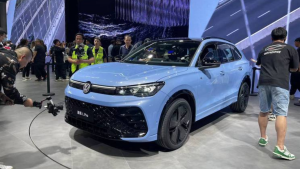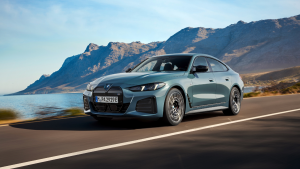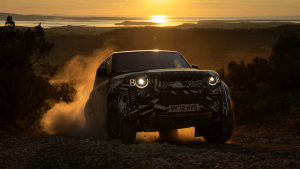Evoque-lution of a species!
Not many concept vehicles have made it to production in nearly the same guise as those that wow showgoers. So when first shown as the Land Rover LRX at the North American International Auto Show, most people assumed that this was purely a figment of some designer's imagination. What many were not prepared for was that Land Rover committed the LRX project to production changing just a few scraps (and crucially re-badging it to Range Rover) resulting in what we now know as
the Evoque.
Positioned to take on the BMW X1 as well as the forthcoming Audi Q3, the Evoque is Range Rover's smallest SUV yet. It is billed as a coupe utility vehicle and not an SUV, quite like BMW's sports activity vehicle. The definitions for these are thin but essentially what they do point out is an elevated driving character within a vehicle that has the good bits of a coupe rolled into an SUV.
But where the dynamics and engine options are quite impressive on paper, what is most impressive is Range Rover's design and style take on what the next generation of SUV should look and feel like both from the outside and inside. The Evoque as I mentioned is a cross between a coupe and an SUV, and while it immediately provokes debate on just how much space a coupe-like form provides inside the cabin due to that low slung roof, let me assure you that for the average Indian body size and weight, it's enough.
Yet there is a sense of claustrophobia because the glass areas by which I mean the windows and not the optional panoramic sunroof are small. The sense of claustrophobia is not eased much by the sunroof either, whose benefit to spaciousness is only apparent when you leave the overhead curtain open in which case it gets relatively hotter inside the cabin. The cabin is otherwise well appointed to seat four passengers with all the modern amenities that one could wish for in a luxury SUV. What's new to the Evoque is an 8-inch touch screen with audio/video and satellite navigation controls all placed on a dashboard that looks more mature and handsome than the conventional Range Rover yet integrates several traditional features such as the rotary gear selector for the automatic version and that chunky steering wheel.
Having put those aspects out of the way the Evoque otherwise is a brilliant design exercise. The exteriors are simply too juicy to ignore when it drives past. It's got an overpowering presence thanks to that high hood line and those chunky flanks all wrapped around that bevelled front end. What makes it even more tantalising is the detailing, such as the ventilated grille, the led clusters, the air intakes on the hood and the massive front bumper and air dam. Together they make a very arresting visual and hide the nightmarish challenges designers faced in packaging the Evoque. The sense of dynamism is elevated even more with the high shoulder line, the low roof and the narrow windows and I quite like the way those lines lead toward the rear tapering in a very strong and muscular visual. There is a latent power suggested by those lines and the thick and broad bodywork heightens the sense of excitement of wanting to get inside the Evoque.
A critical part of the brief for the LRX concept, which spawned the Evoque was to keep the dimensions compact without losing any of the Land Rover heritage and traditional strengths. What that essentially meant was that designers had to come up with an SUV which was compact enough to take on the X1 and the Q3 but yet have all the necessary all-terrain abilities of any full scale Land Rover. The only place the designers could find the bandwidth to package the Evoque the way it is, was by extruding a new chassis from their Land Rover Mid Size platform which is also the base of the Freelander. So the platform was compressed to keep the height and interior space requirements as specified in the original brief. To retain structural integrity and strength new construction methods and stronger and lighter materials were employed to build the chassis. Eventually smart packaging for instance resulted in the 70-litre tank being shaped in a very un-tank like shape retaining a high ground clearance, a 420-litre boot, a space saver spare wheel in the boot and the option to go with full 20" wheels and tyres if a customer desired it.
Even the engine bay had to be packaged to accommodate the engine and its ancillary components. So a new sub frame was built and new engine installation points as well as a new air induction system were created to keep in mind that the Evoque was a go anywhere as extreme as it gets Range Rover.
But a review of just how well all these aspects work together is still a few months away when the Evoque finally hits production.
It however is not possible to cut corners when it comes to technology, while aiming to provide the same driving experience as any other Range Rover. And the Evoque in fact remarkably adds a few more skills to its burgeoning list of capabilities, one of which is a new terrain response system that now also features a dynamic drive mode.
While I did not get an opportunity to drive the Evoque around Land Rover's Gaydon test facility, I must say I was deeply impressed with the manner in which the test engineers threw it around a narrow and heavily scarred track with me perched in the passenger seat. The Evoque felt perfectly at ease, showing off a dynamic character that I last experienced in the BMW X6. It tracked a flat line through any corner and the dynamic suspension whose dampers feature MagneRide (see MagneRide box) kept body roll and pitch under tight rein. However what you do get along with the impressive handling is a stiff ride quality that announces every scar, every tarmac fracture and pebble as distinctly and loudly as a butler announcing each and every guest at a ball. Still I shouldn't harp about the ride, it really isn't as significant when you consider that most countries have far superior roads than us in India. The test facility breaks the road surface down to the worst they can muster and most of the irregularities then can only be felt at low speeds. At full clip the MagneRide irons out all the creases and what you feel is a faint jitter and nothing else. Damping and rebound are also impressive and even over erratic undulations the Evoque does not lose its composure and levels out instantly.
In most standard terrain response modes the ECU recalibrates the engine, gearbox, suspension, the variable ratio power steering and the centre coupling. But in the new dynamic mode, it further stiffens the suspension and sharpens steering feedback and responses, complementing the Evoque's coupe-like aspirations. Dynamic traction mode also relaxes the stability control programs by a small margin to allow the driver more control over the vehicle. So, if needed you can turn a potentially dangerous understeer moment into oversteer to regain control.
Where all Range Rover models were previously only 4WD, the Evoque is the first to offer a choice between 4WD and 2WD, the front wheels being the driven wheels. Dynamic systems however don't alter their course and the same set of values is applied irrespective of the drivetrain. The 2WD is of course targeted at emerging markets where efficiency is more important than go anywhere ability.
The trick bits don't stop there. A dynamic stability program has been advanced to use yaw sensors to detect loss of stability and remedy the situation while at the same time excessive understeer initiates a different program that automatically reduces speed before driver intervention is possible and thereby provides some semblance of grip before the driver can take over.
Like all Range Rovers, the Evoque also has Terran Response with four off-road programs though there's no low-ratio. At 212mm, ground clearance is as much as the Range Rover Sport and more than the Q7 and X1. It has 25° entry and 33° departure angles and has a minimum wading depth of 550mm including entry/exit of 25°.
It has a hill descent feature but for the first time you can adjust the speed of decent electronically. It also has a hill hold function that allows the Evoque to climb uphill even in icy conditions without losing traction. In such conditions it applies the brakes for a few seconds preventing rollback when the driver releases the brake pedal and steps on the gas. It will also progressively release the brakes when climbing providing complete control to the driver. It even has a built-in failure protection system, in case the Evoque can't find traction and slides backwards, it will do so at speeds of no more than 5kmph allowing the driver to regain full control of the Evoque.
Complementing the array of dynamic and off-road elements is a range of two 4-cylinder engines, with three output options from the diesel and a direct injection petrol. Why just 4-cylinder and not a V6 boils down to packaging. The Evoque's engine bay is a compact area and placing a large engine within its confines proved to be too big a challenge to find a solution for.
Now the eD4 is the smallest engine in the Evoque, and it is also the lightest diesel engine Land Rover has ever built. This 4-cylinder turbocharged engine is mated to a 2WD drivetrain alone and it is the most efficient package within the Evoque. It is 75kg lighter than the 4WD variant, has carbon dioxide emission below 130gm/km and promises high fuel efficiency ratings. Power output is an adequate 150PS and torque a generous 380Nm. A 6-speed manual transmission is standard which accelerates the Evoque from 0-100kmph in 10.6 seconds.
There are two more diesel options. The same 150PS engine mated to a 4WD drivetrain is one of them though torque output is a bit higher at 400Nm. The other is the most powerful diesel in the Evoque with 190PS and 420Nm of torque also mated to a full time 4WD system. This is the same engine used for the upcoming XF and features the same set of features, start stop, brake regenerative energy tech and enhanced NVH levels. Six-speed manual and automatic transmissions options are also available, except for the 190PS engine which features the 6-speed automatic alone.
The 2.0-litre direct injection all-aluminum alloy petrol engine features twin (both intake and exhaust) variable valve timing along with direct injection, twin balancer shafts and a turbocharger. It makes 240PS of max power with 340Nm of torque. The turbo is a lightweight unit that has been tuned to reduce lag and deliver quicker responses.
On the short test loop there really wasn't much to understand about how the engines felt, but what I did appreciate was that even the 150PS diesel felt punchy and brisk, not to mention quiet with refinement quite unlike any diesel. So not only does it offer excellent dynamics but the engines also feel very promising though only a full drive of the Evoque a little later this year will tell us just how dynamic the powertrain is though on paper this does appear to be very impressive.
Overall what I experienced is still a prototype and a few changes are still expected. The India launch is nearly a year away a little after the Evoque is launched globally. That however should not curb the enthusiasm for the Evoque as it truly is one of the most outstanding Range Rovers ever built, a proper evolution of a species that for decades has pioneered the world of 4x4 motoring.
Starts Rs 32.48 Lakhs
1968cc
Automatic
150
380
15.17 Kmpl
Starts Rs 35.9 Lakhs
1995cc
Automatic
190
400
-NA-
Starts Rs 95 Lakhs
2998cc
Automatic
340
450
10.31 Kmpl
Related Stories
Top Stories
Latest Videos
Most Popular
- Budget Sportbike Showdown: Kawasaki Ninja 500 vs Aprilia RS 457 vs Yamaha YZF-R3
- 2014 Triumph Daytona 675 vs 2024 Kawasaki ZX6R - A Decade of Evolution in Supersport Motorcycles
- Mumbai-Pune Expressway speed restrictions updated
- Bajaj NS400 picture leaked ahead of its launch
- 2024 Bajaj Pulsar N160 launched at Rs 1.39 lakh; gets USD forks & new features










